Trains, buses and people: More lessons for Charlotte
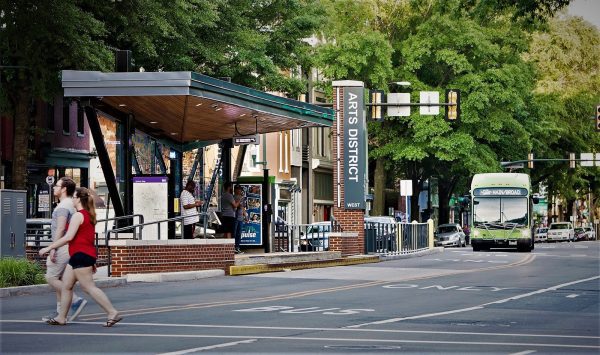
Part 1 of this series focused on what ails bus systems in major U.S. cities, and how the Charlotte Area Transit System is attempting to reverse its own downward trend in bus ridership. But buses are only one piece of a complicated transit puzzle of what works, what doesn’t, and why.
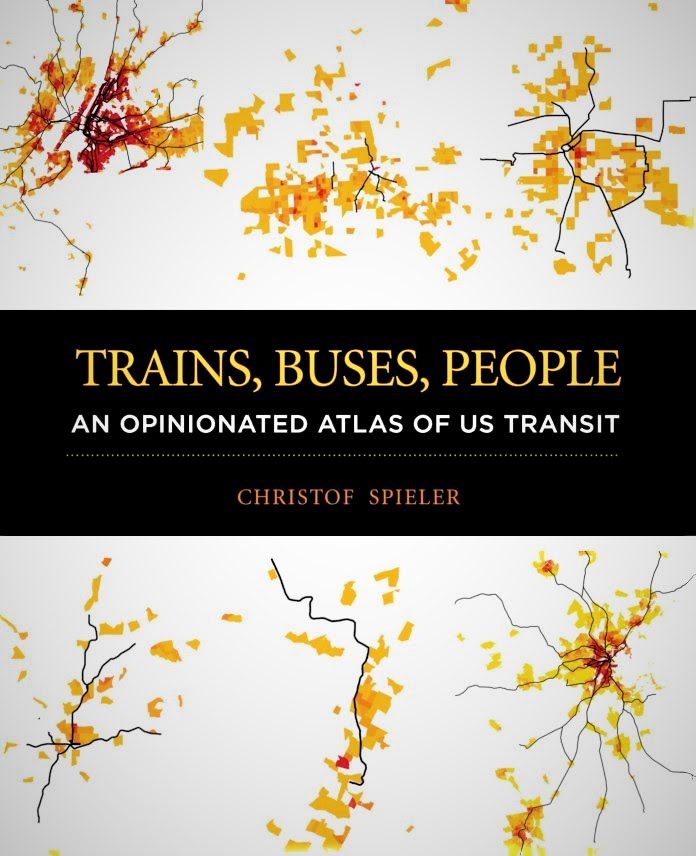 In his recent book, Trains, Buses, People – An Opinionated Atlas of US Transit, Christof Spieler dispenses a refreshly forthright assessment of 47 of America’s larger systems, including Miami, Atlanta, Austin, Houston, Dallas and other Sun Belt cities. Never before has a publication compared this many cities and transit modes for a mainstream audience.
In his recent book, Trains, Buses, People – An Opinionated Atlas of US Transit, Christof Spieler dispenses a refreshly forthright assessment of 47 of America’s larger systems, including Miami, Atlanta, Austin, Houston, Dallas and other Sun Belt cities. Never before has a publication compared this many cities and transit modes for a mainstream audience.
Research included photographs at all locations and interviews with agency staff, elected officials, and advocates. The final product is compressed into a digestible format of full-page maps, abundant infographics and the author’s informed commentary. Spieler’s opinions derive from several complex factors: political dynamics, funding challenges, planning dilemmas, land use constraints, ridership fluctuations, and conceptual biases all come into play.
He reveals a few winners, but also a lot of losers. Charlotte hovers precariously in between.
Here’s a snapshot of four metro regions besides Charlotte — what they got right — and wrong.
Urban transit in the U.S. leaves much to be desired, argues Spieler, a veteran transit planner who consults from Houston. This is despite huge modernization initiatives and billions of dollars invested since the transit resurgence began in the 1970s.
“It is remarkable how much of the transit we build in the U.S. doesn’t go where people want to go or when they want to get there,” Spieler said.
Dallas-Fort Worth
Dallas-Fort Worth, (metro population 7,352,000), is a sobering case in point. Its system demonstrates that mammoth infrastructure and plenty of transit options do not necessarily attract a proportional customer base.
Since 1995, the region has gained more than 150 miles of rail service. That’s the greatest increase in the country. Downtown itself has two streetcar lines, seven light-rail lines and commuter or intercity rail in every direction reaching as far as 32 miles west to Fort Worth. What these lines avoid along the way is a whole other consideration.
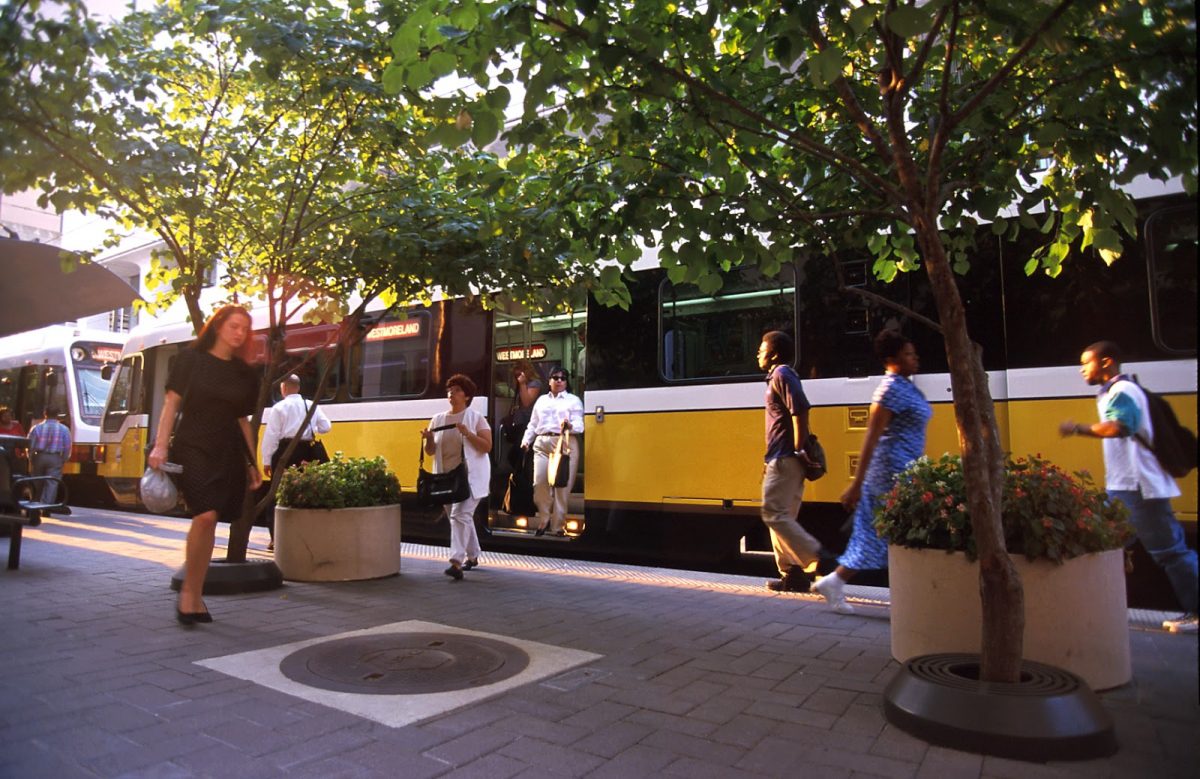 Dallas went Texas-style with its mammoth regional transit system. But it fails to meet the ridership test.
Dallas went Texas-style with its mammoth regional transit system. But it fails to meet the ridership test.
Photo credit: DART photo library.
Dallas’s Achilles heel is the unintended consequence of running new rail service on pre-existing freight tracks. Instead of connecting to high activity destinations, the tracks skirt them. They bypass the Love Field airport terminal, Southern Methodist University, the University of Dallas and some of the city’s denser neighborhoods.
DART’s 93 miles of light-rail is the longest stretch in the U.S, and yet ridership, at a paltry 36 weekday rides per 1000 metro residents, lags far behind much smaller networks like San Diego, Portland or even Phoenix. Spieler’s assessment: “Arguably, DART has achieved its primary design goals: high ridership was just not one of them”.
Nashville
Another dysfunctional system is the Nashville-Davidson-Murfreesboro MTA (metro population: 1,912,819). Its low status reflects a murky history of subpar funding and dubious compromises.
Its sole commuter rail line, the Music City Star, is a project “born out of opportunity, not need.” Like Dallas’s DART, it runs on existing tracks that avoid the denser population zones. Frequency is at a mere four to six daily trips in each direction.
Opportunity for a huge breakthrough came in 2018, but voters rejected the $5.4 billion expansion plan by a distressing margin — at a time when the system’s 18 weekday trips per 1000 metro residents was less than half that of Dallas’s DART. Regrettably, Nashville can’t seem to muster the political will power to fund major investment or attract passengers.
Richmond
Charlotte’s smaller neighbor to the northeast (metro population 1,260,029), gets two thumbs up from Spieler. In a city lacking modes other than buses, the recently built 7.6 mile bus rapid transit line, Pulse, has garnered national attention.
Pulse connects passengers to 14 stations at frequent intervals, many at major activity nodes along Broad street, the most heavily-used bus corridor in the city. (“Frequent” is defined throughout the atlas as “routes that run at least every 15 minutes on weekdays from 7 a.m. to 6 p.m.”) Arrival times are posted on digital displays at the bus stops, and much of the route consists of bus-only lanes, an important design feature to overcome traffic delays.
The results have been impressive, marked by a 17% ridership bump in 2018. This is but one example of many cited by Spieler to demonstrate that rail is not always the best answer to customer needs.
Seattle-Tacoma
The Seattle-Tacoma metro region (metro population 4,527,000), gets the highest marks from Spieler: “In the 21st century, no other U.S. city has committed to transit as dramatically.”
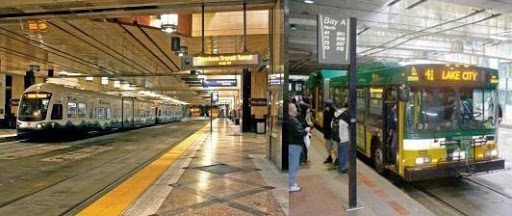 Seattle’s handsome downtown Transit Tunnel is 1.3 miles long and shelters several transit stops. In 2019 it was converted to rail only. One of many assets marking Seattle -Tacoma as a winner. Photo: Lyndon Henry.
Seattle’s handsome downtown Transit Tunnel is 1.3 miles long and shelters several transit stops. In 2019 it was converted to rail only. One of many assets marking Seattle -Tacoma as a winner. Photo: Lyndon Henry.
The success of the Sound Transit system is partly the outcome of overwhelming public support in 2016 for $53.8 billion in bonds and taxes, and that’s on top of earlier funding for projects still in the pipeline. Its annual budget is a whopping $1.6 billion.
Sound Transit has light rail, commuter rail, intercity rail, frequent bus lines, two streetcar lines, ferry service and even a 1.2-mile monorail. A regional farecard, Orca, can be used interchangeably between seven different transit operators.
Although 2017 marked another year of transit rider loss nationally, Seattle’s numbers went up. Suburban commuters to downtown Seattle continued to use the system in droves, with 47% boarding public transit. Equally impressive: from 2010 to 2016 downtown Seattle gained 45,000 jobs, with 95% of the added trips by walking, biking or transit.
Seattle’s 152 transit trips per 1,000 metro residents is almost five times greater than Dallas-Fort Worth.
Charlotte
Our own Charlotte metro region ranks 24th in population (2,540,000). Spieler’s commentary here is dated because the atlas was published in 2018, shortly after the opening of the LYNX Blue Line Extension.
However, he anticipates redesigning the CATS bus network by connecting at light rail stations and adding more crosstown routes.He also acknowledges the remarkable transit-oriented development that continues to acclerate — not only in south Charlotte and Uptown, but moving northeast at the Parkwood, 25th Street, NoDa, University City Boulevard and JW Clay/UNC Charlotte stations.
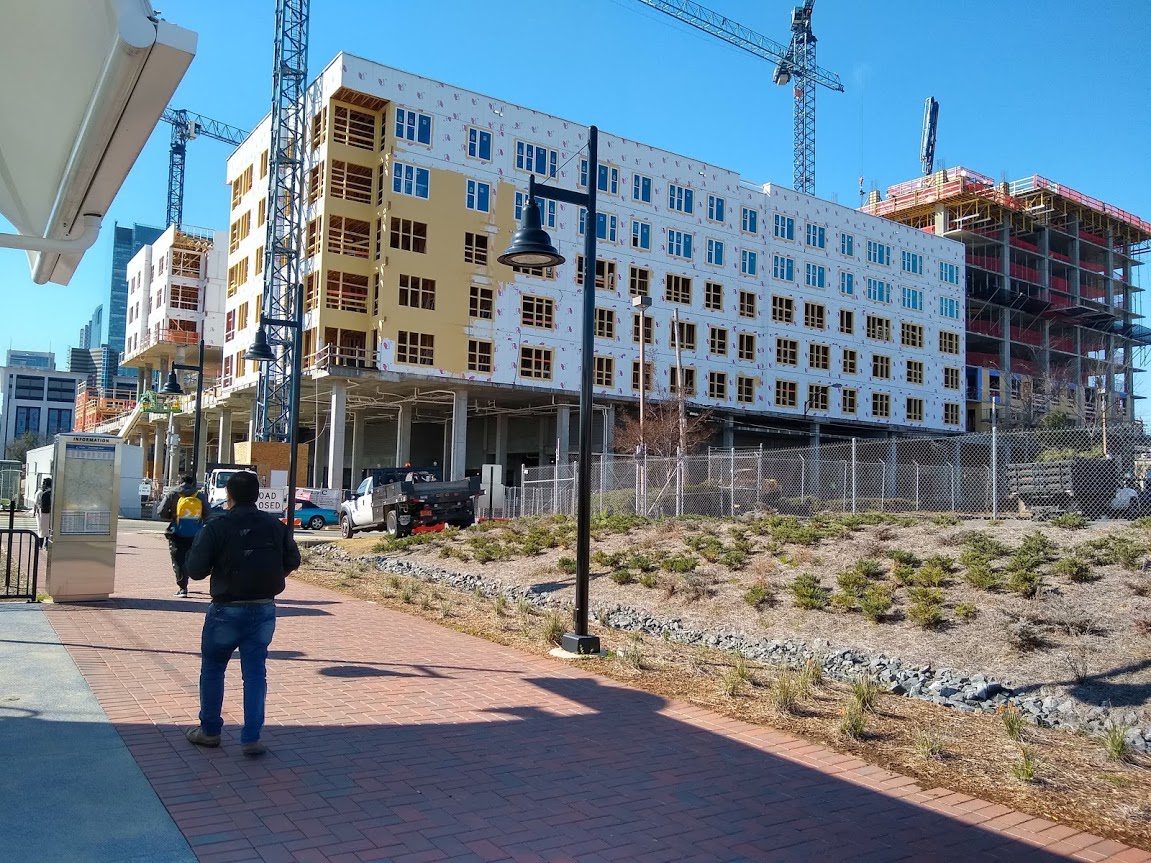 The Ellis project viewed from the Ninth street LYNX station. Project mix: 549 apartments (some subsidized) and 19,300 sq. ft. of ground floor commercial. Photo credit: Martin Zimmerman.
The Ellis project viewed from the Ninth street LYNX station. Project mix: 549 apartments (some subsidized) and 19,300 sq. ft. of ground floor commercial. Photo credit: Martin Zimmerman.
Should Spieler visit Charlotte today, he would probably applaud CATS CEO John Lewis’s campaign to fund the next big system expansion. And he might also remind us that even if multibillion dollar investment leads to build-out of the Silver Line and completion of the Envision My Ride bus program, these upgrades would not necessarily guarantee more customers.
Spieler’s 2017-18 ridership metrics for bus and rail showed weekday trips per 1,000 metro residents hovering at a mere 35. Based upon similar numbers from other sources, this metric did not change appreciably in 2019. It’s a worrisome number, falling a tad below the lowly Dallas-Fort Worth level.
Trains, Buses, People also contains valuable guidance on performance objectives for any system — frequency, reliability, travel time, density, walkability, etc. Meeting these objectives is essential when deciding on transit futures in a sustainable city context.
Solving the transit puzzle involves much more than infrastructure, design, or development densities. Ultimately, it’s customer satisfaction and loyalty that determines success or failure.
Consider this atlas an indispensable resource for anyone eager to make the Charlotte region a strong competitor among its transit peers, and not just a wanna-be.
Martin Zimmerman is a Charlotte planner and urban journalist. His commentaries on issues of transportation, smart growth, and low-carbon cities appear frequently in Plan Charlotte. He directs City Wise Studio USA.